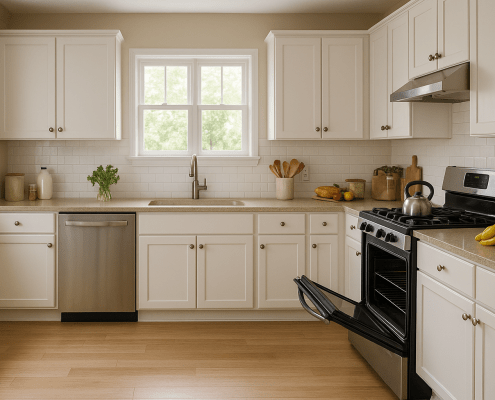Easy Microwave Prep for Thanksgiving
Samantha Bullington / Friday November 3, 2023
The microwave is one of the busiest appliances in most kitchens, but during the holidays it goes into overdrive. Thanksgiving is one of the biggest cooking days of the year, and your microwave will likely be called upon repeatedly to reheat leftovers, cook vegetables, melt butter, and more. Going through this easy microwave prep will help you get through the holiday with the microwave intact.
Make sure you are not waiting till the last minute to check the unit in case parts are needed. Remember if you have to order any parts there could be delays because of the Holiday so the sooner you check the unit and get the parts ordered the better luck you are going to have with getting the part on time.
Deep Clean the Interior
Give your microwave a thorough deep cleaning about one week before Thanksgiving to eliminate any odors, food residue, grease buildup, and bacteria. Here’s a simple cleaning procedure:
- Remove the turntable, turntable support, racks, and other removable parts. Wash thoroughly by hand using hot water and dish soap or place in the dishwasher.
- Mix together baking soda and water to form a spreadable paste. Apply the paste to stained or sticky areas inside the microwave using a sponge or cloth. Avoid getting paste near the vents.
- Fill a microwave-safe bowl with 1 cup of distilled white vinegar. Microwave the vinegar for 2-3 minutes until boiling. This will loosen grease and food splatters.
- Let the microwave cool for 5 minutes after heating the vinegar. Then open the door and use paper towels to carefully wipe away dirt and grime. The steam will soften baked-on foods.
- Use disinfectant wipes or a 50/50 vinegar and water solution to sanitize the interior. Pay close attention to greasy areas like the ceiling and walls near the vent.
- Rinse with a clean, damp cloth and wipe dry. Replace all removable parts once clean.
Read more: How to Clean a Microwave
Check Door Seals, Hinges and Latches
It’s important that the microwave door closes properly and seals tightly to allow cooking and prevent leaks. Inspect the door gaskets and hinges for any signs of damage prior to Thanksgiving, and perform repairs immediately if needed.
- Examine the gasket (seal) around the door for cracks or missing sections. It should be pliable and sit flush against the microwave when closed.
- Test the door’s closing and opening motion. It should open and shut smoothly without any sticking. Listen for clicking noises which can indicate a problem.
- Check that the latch engages and holds the door closed. You should hear an audible click when the latch connects.
- Contact AppliancePartsPros.com if any replacement parts are needed. Don’t try to use the microwave if the door is not sealing fully.
Interior Light Bulb
The interior light allows you to view food as it is cooking and indicates when the cooking cycle ends. Replace burnt-out bulbs:
- Make sure the microwave is unplugged before replacing the bulb! This prevents accidental shocks.
- Remove the casing cover to access the bulb. Some models require prying off a vented grill panel.
- Check your owner’s manual for details on your microwave’s bulb type and wattage. Most use 40-watt bulbs.
- Twist the old bulb counterclockwise to remove it from the socket. Insert the new bulb and twist it clockwise until tightened.
- Replace the bulb cover. Plug back in the microwave and test the light.
Watch: How to replace light bulb
Inspect the Turntable and Roller Ring
The turntable and roller ring should rotate smoothly each time you use the microwave. Friction can cause these components to eventually wear down.
- Remove food residue from the turntable surface and roller guide area. Built up food can impede turning.
- Test rotation by spinning the turntable by hand. It should have a minimal wobble and turn easily.
- Listen for any loud or grinding noises when the turntable operates. Noisy operation indicates worn parts.
- Replace the turntable if needed. New replacement turntables are inexpensive and easy to install.
Watch: How to replace turntable ring
Clean the Exterior Surfaces
While you’re cleaning the inside, don’t forget to wipe down the exterior surfaces including the housing, door, control panel, and vent grating.
- Use a soft cloth or sponge with warm water and mild soap. Avoid abrasive cleaners.
- Pay attention to greasy areas like around the vent fan and any openings.
- Gently hand wash control panels. Don’t use excessive water near controls.
- Rinse surfaces and wipe dry with a soft cloth.
- Use stainless steel appliance cleaner on stainless steel models.
Read more: Removing Scratches From Stainless Steel Appliances
Verify Accuracy of Cook Settings
Make sure the microwave’s power levels, pre-programmed settings, and timer are all working accurately. Inaccurate cook times can lead to improperly cooked or unsafe food.
- Heat a cup of water on high (100% power) for 1 minute. The water should be steaming hot and possibly start boiling.
- Test each power level (10%, 30%, 50% etc) by cooking for 1 minute. Lower power levels provide less intense heating.
- Try pre-set buttons like “Popcorn” and “Reheat.” Make sure they match the expected cook times.
- Use a kitchen timer to verify the minute timer. Count down 1 minute manually as the microwave counts.
Clean the Ventilation Filters
Prevent odors and keep airflow proper by cleaning the ventilation filters before Thanksgiving:
- Locate the grease filter, charcoal filter, or fan ventilation filter. Check your model’s manual if unsure.
- Remove the filter(s) and soak in warm soapy water. Agitate to remove thick grease.
- Rinse thoroughly until water runs clear. Allow to air dry fully before replacing.
- Replace filters at least once annually. Monthly cleaning is best for heavy use.
- Baking soda or diluted vinegar can be used for odor removal.
Read more: How To Clean A Microwave Grease Filter
Power Cord and Outlet
Electrical issues can lead to dangerous malfunctions or fires. Verify the power cord is undamaged and firmly plugged into a dedicated outlet.
- Look for cracks, fraying, or damaged insulation on the cord. Don’t use if the ground prong is broken or missing.
- The outlet should have space on either side to allow ventilation. Don’t allow the cord to be pinched.
- Avoid using an extension cord if possible. Never use a thinner gauge cord than the appliance cord.
- Test ground fault circuit interrupter (GFCI) outlets. Use the test/reset buttons monthly.
- Replace damaged cords or faulty outlets. Poor connections cause power fluctuations.
What can go in the microwave
Misusing your microwave’s functions can be dangerous. Prior to Thanksgiving, read your owner’s manual and understand the appliance’s intended uses. Key safety tips:
- Never run the microwave empty. This can destroy the magnetron that generates the microwaves.
- Don’t use metal containers or aluminum foil inside. This causes arching that can damage the oven.
- Only microwave approved plastics. Other plastics can melt or release chemicals. Look for the microwave-safe label.
- Don’t microwave eggs in the shell. Pressure buildup causes them to explode.
- Allow standing times. Food keeps cooking slightly after microwaving.
- Stir foods multiple times during cooking. This prevents uneven hot spots.
Learning what not to do with your microwave is just as important as how to use it properly.
Read more: Common Mistakes That Shorten The Lifespan Of Appliances
Safe Microwaving
Follow general safety practices when operating your microwave to prevent accidents:
- Use potholders or oven mitts when handling hot containers.
- Allow foods to cool briefly before removing from microwave to avoid steam burns.
- Don’t leave microwaving foods unattended. Boil overs make a mess.
- Keep the exterior and vents clear to allow airflow.
- Clear clutter from the counter area and keep young children away.
- Stop the microwave immediately if you see sparks or plumes of smoke.
Simple precautions and awareness when cooking protect you and your family.
More Tips
Caring for your microwave properly before the Thanksgiving crunch can make sure it survives the increased holiday workload and continues working properly. Your microwave will deliver quick cooking results for Thanksgiving leftovers, pies, appetizers, and more all season long when you take the time to get it inspection-ready beforehand. With some simple TLC and microwave prep your unit will be able to handle the turkey day cooking frenzy with ease.
Thanks for reading! If you have any other appliance repair needs or projects, you can find other resources and our DIY blog at AppliancePartsPros.com. There, you can enter your model number to order the exact parts you need. Most orders arrive in 2-3 business days.
You can also reach our award-winning customer service team at 1-877-477-7278, chat with a pro on our website and watch thousands of free video tutorials on our YouTube channel.
Hey there, I’m Samantha and I’m super excited to be a part of the Appliance Parts Pros team! With 9 years of experience, I’ve had the awesome opportunity to assist countless customers in troubleshooting their home appliances and finding DIY repair solutions.





